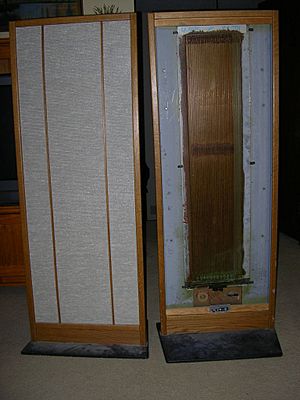Magnetostatic loudspeaker facts for kids
A magnetostatic loudspeaker is a special type of speaker that creates sound using magnets and electric currents. Unlike many common speakers, it's a "dipole" speaker, meaning it sends sound out from both its front and back sides. These speakers are known for producing very clear and detailed sound.
Contents
What Are Loudspeakers?
Loudspeakers are devices that turn electrical signals into sound waves that we can hear. Think of them as the voice of your music player, TV, or computer. They work by making parts inside them vibrate very quickly, which then makes the air around them vibrate, creating sound.
How Magnetostatic Speakers Make Sound
Magnetostatic speakers work in a unique way. They have a very thin, flat material, often called a "diaphragm," that has electrical wires or conductors built into it. This diaphragm is placed between strong magnets.
When an electrical signal (like music) from an amplifier goes through the wires on the diaphragm, it creates a magnetic field around those wires. This new magnetic field interacts with the strong, fixed magnets around it. Because of this interaction, the diaphragm moves back and forth very quickly. This movement pushes and pulls the air, creating the sound waves we hear.
What is a Dipole Speaker?
A magnetostatic speaker is often called a "dipole" speaker. This means it produces sound from both its front and its back. Imagine a ripple in a pond: it spreads out in all directions. A dipole speaker is a bit like that for sound. The sound coming from the back of the speaker is usually out of phase with the sound from the front, meaning it's the opposite of the front sound. This unique way of spreading sound can make music sound more open and spacious in a room.
Magnetostatic vs. Electrostatic Speakers
You might hear about "electrostatic loudspeakers" too. Magnetostatic speakers are similar but have a key difference. Electrostatic speakers use very high voltages to make their diaphragms move. Magnetostatic speakers, on the other hand, use higher currents. This difference in how they're powered affects their design and how they interact with the equipment that drives them.
Connecting to an Amplifier
Magnetostatic speakers sometimes have a very low impedance. Think of impedance as how much a speaker "resists" the flow of electricity from an amplifier. If a speaker has low impedance, it means it needs a lot of electrical current to work properly. Because of this, you need a powerful amplifier that is designed to handle these low-impedance speakers to get the best sound quality.
Sound Quality
Magnetostatic speakers are highly respected for their excellent sound quality. They are known for producing very clear, detailed, and natural-sounding audio. Because their diaphragms are often large and light, they can respond very quickly to changes in the music, which helps create that precise and lifelike sound. Many audio enthusiasts choose magnetostatic speakers for their home sound systems because of this high-fidelity performance.


